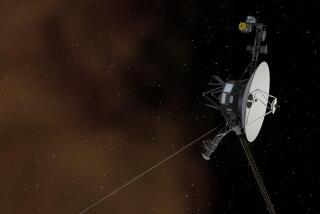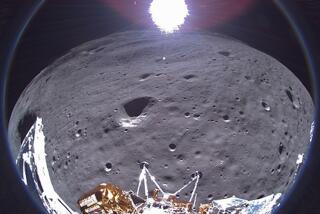Europe Still Expects Call From Mars
For the second nerve-racking day, British scientists waited in vain Friday for their Beagle 2 lander to phone home and confirm that it had landed safely on Mars.
The 26-inch-wide craft was scheduled to touch down Wednesday evening on the Red Planet, but it has missed four opportunities to contact its controllers on Earth, suggesting that the lander has encountered serious difficulties.
“It’s like sending somebody a love letter, and you know they got it and you’re waiting for a response,” said Colin Pillinger of Open University, the lead scientist for the Beagle project.
“We are not in any way giving up yet,” the planetary scientist added.
NASA’s Mars Odyssey orbiter has now flown over Beagle 2’s Isidis Planitia landing site without receiving a signal from the tiny craft, which could mean that the probe did not land where it was expected to or that the communications systems of the two space vehicles were not compatible.
More troubling was the inability of Britain’s massive Jodrell Bank radio telescope to pick up the probe’s weak radio signal during two two-hour periods when it should have been in direct line of sight. That suggests something more serious may have gone wrong with the probe -- that its pocket-watch-like pod did not open, that its antenna was not able to unfold or, even worse, that it crashed into the surface and was destroyed.
A radio telescope at Stanford University in California will join in the search today, and others around the world may listen in as well on the off-chance that Beagle’s internal clock is out of kilter and transmitting its homing signal at the wrong times. Odyssey will pass over it once a day as well and listen for a call.
“We’re still optimistic,” said a European Space Agency official at the agency’s headquarters in Darmstadt, Germany.
Beginning Jan. 4, engineers also will be able to attempt communications through Beagle 2’s mother ship, Mars Express, which went into orbit around Mars about the time Beagle was supposed to be landing.
Controllers have to make several adjustments to the mother ship’s orbit before it could be in position to contact the lander, but they hope the effort will be more successful because the two crafts’ communications systems already have been shown to be compatible.
Although disappointed about the inability to contact Beagle 2, ESA officials stressed that the success of Mars Express in entering orbit was a scientific triumph.
The craft is scheduled to photograph the surface of the planet for two years and to use its powerful radar to search for underground water.
“The landing probe on Mars is, in essence, the icing on the cake,” said ESA’s Gerhard Schwehm. “For the scientists here, the orbiter is the most important part of the mission.”
More to Read
Sign up for Essential California
The most important California stories and recommendations in your inbox every morning.
You may occasionally receive promotional content from the Los Angeles Times.










